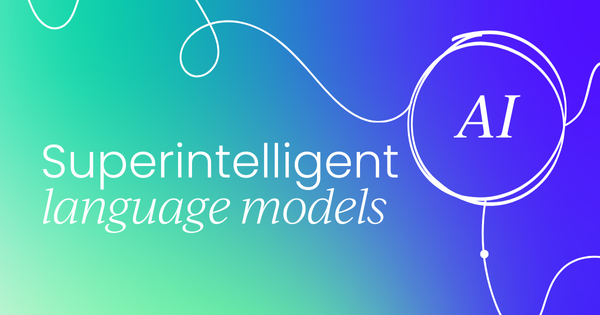As the field of artificial intelligence continues to push the boundaries of what's possible, one development has captivated the world's attention like no other: the meteoric rise of large language models (LLMs).
These AI systems, trained on vast troves of textual data, are not only demonstrating remarkable capabilities in natural language processing and generation, but they are also beginning to exhibit signs of something far more profound—the emergence of artificial general intelligence (AGI).
The pursuit of AGI: From dream to reality
Artificial General Intelligence (AGI), also known as "strong AI" or "human-level AI," refers to the hypothetical development of AI systems that can match or exceed human-level intelligence across a broad range of cognitive tasks and domains. The idea of AGI has been a longstanding goal and subject of intense interest and speculation within the field of artificial intelligence.
The roots of AGI can be traced back to the early days of AI research in the 1950s and 1960s. During this period, pioneering scientists and thinkers, such as Alan Turing, John McCarthy, and Marvin Minsky, envisioned the possibility of creating machines that could think and reason in a general, flexible manner, much like the human mind. However, the path to AGI has proven to be far more challenging than initially anticipated.
For decades, AI research focused primarily on "narrow AI" – systems that excelled at specific, well-defined tasks, such as chess playing, language translation, or image recognition. These systems were highly specialized and lacked the broad, adaptable intelligence that characterizes human cognition.

The breakthrough of LLMs: A step toward AGI
The breakthrough that has reignited the pursuit of AGI is the rapid advancements in large language models (LLMs), such as GPT-3, DALL-E, and ChatGPT. These models, trained on vast troves of textual data, have demonstrated an unprecedented ability to engage in natural language processing, generation, and even reasoning in ways that resemble human-like intelligence.
As these LLMs have grown in scale and complexity, researchers have begun to observe the emergence of "superintelligent" capabilities that go beyond their original training objectives. These include the ability to:
- Engage in multifaceted, contextual dialog and communication.
- Synthesize information from diverse sources to generate novel insights and solutions.
- Exhibit flexible, adaptable problem-solving skills that can be transferred to new domains.
- Demonstrate rudimentary forms of causal and logical reasoning, akin to human cognition.
These emergent capabilities in LLMs have led many AI researchers to believe that we are witnessing the early stages of a transition towards more general, human-like intelligence in artificial systems. While these models are still narrow in their focus and lack the full breadth of human intelligence, the rapid progress has ignited hopes that AGI may be within reach in the coming decades.
Challenges on the road to AGI: Ethical and technical hurdles
However, the path to AGI remains fraught with challenges and uncertainties. Researchers must grapple with issues such as the inherent biases and limitations of training data, the need for more robust safety and ethical frameworks, and the fundamental barriers to replicating the full complexity and flexibility of the human mind.
One of the key drivers behind this rapid evolution is the exponential scaling of LLM architectures and training datasets. As researchers pour more computational resources and larger volumes of textual data into these models, they are unlocking novel emergent capabilities that go far beyond their original design.
"It's almost as if these LLMs are developing a sort of artificial cognition," muses Dr. Samantha Blackwell, a leading researcher in the field of machine learning. "They're not just regurgitating information; they're making connections, drawing inferences, and even generating novel ideas in ways that mimic the flexibility and adaptability of the human mind."
This newfound cognitive prowess has profound implications for the future of artificial intelligence. Imagine LLMs that can not only engage in natural dialog, but also assist in scientific research, devise complex strategies, and even tackle open-ended, creative tasks. The potential applications are staggering, from revolutionizing customer service and content creation to accelerating breakthroughs in fields like medicine, engineering, and beyond.

Navigating the ethical challenges of AI
But with great power comes great responsibility, and the rise of superintelligent language models also raises critical questions about the ethical and societal implications of these technologies. How can we ensure that these systems are developed and deployed in a way that prioritizes human well-being and avoids unintended consequences? What safeguards must be put in place to mitigate the risks of bias, privacy violations, and the potential misuse of these powerful AI tools?
These are the challenges that researchers and policymakers must grapple with in the years to come. And as the capabilities of LLMs continue to evolve, the need for a thoughtful, proactive approach to AI governance and stewardship will only become more urgent.
"We're at a pivotal moment in the history of artificial intelligence," Dr. Blackwell concludes. "The emergence of superintelligent language models is a watershed event that could fundamentally reshape our world. But how we navigate this transformation will determine whether we harness the incredible potential of these technologies or face the perils of unchecked AI development. The future is ours to shape, but we must act with wisdom, foresight, and a deep commitment to the well-being of humanity."
Want to know more about AI governance?
Make sure to give the article below a read:




 Follow us on LinkedIn
Follow us on LinkedIn



